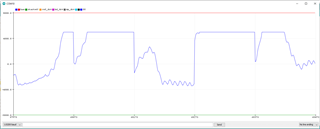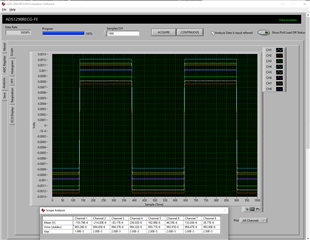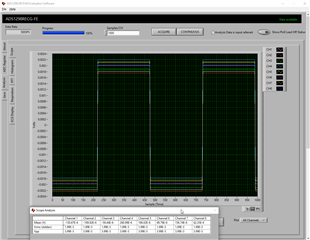Other Parts Discussed in Thread: ADS1298ECGFE-PDK
Hello,
I am using ADS1294 and trying to measure signal from Channel 2. I am not sure if I am configuring the registers of ADS 1294 correctly. I am able to read and write data to the registers correctly. I am also not sure if the voltages of my supply and other pins are correct.
My voltages at different pins are as follows:
Avdd: 2.45V
Avss: -2.6V
Vrefp: 0 // My question is it suppose to be 0 V or +2.5V?
Vrefn: -2.6V // I can configure this to set it to -2.5V depending on my LDO feedback resistor
Vcap1: -1.38V
Vcap2: 0V
Vcap3 = 4.3V
Vcap4 = -1.4V
DVDD: 2.5V // I can configure it to ~1.8V if needed
My register configuration are:
ID:(0x90);
Config1:(0x86)
Config2:(0x00)
Config3:(0xC0)
Loff:(0x00)
Ch1:(0x81)
Ch2(0x00)
Ch3:(0x81)
Ch4(0x81)
Please note these are the same registers configuration read from ADS chip over SPI communication.
Procedure which I follow in my code to get the data:
1) on start up I reset it by sensing 0x06 command
2) Then I write the registers by first sending SDATAC command (0x11)
3) Then I send WREN command (0x40) & (0X08), to start writing register from address 0x00 and total register written is 9 hence second byte will be 0x08
4) I then send START command (0x08) after some interval
5) Then RDATAC command (0x10)
6) Make CS high
7) Wait till DRDY becomes low and if low then make CS low and read all the data which is in my case 15 bytes
Questions:
1) my major concern is the voltages. Is it okay if Vrefp is 0V and DVDD is 2.5V. I missed out 1.8V supply in my design hence applying 2.5V to DVDD with current limiting resistors to limit it to max 3mA..
2) To read ECG signals are the register configurations correct. I am not trying to measure internal test signal.
Thanks,





